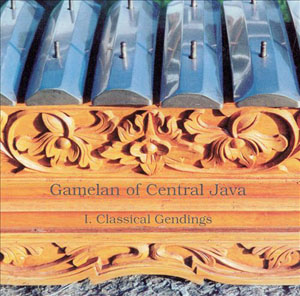Vol. I: Classical Gendings (Felmay, 2001)
Vol. II: Ceremonial Music (Felmay, 2002)
Vol. III: Modes and Timbres (Felmay, 2004)
Vol. IV: Spiritual Music (Felmay, 2004).
 It occurs to me, embarking on the exploration of central Javanese gamelan, that some explanation of terminology is in order, although I have touched on some of this information in discussing Balinese music.
It occurs to me, embarking on the exploration of central Javanese gamelan, that some explanation of terminology is in order, although I have touched on some of this information in discussing Balinese music.
First, the term “gamelan” refers to the orchestra, the group of instruments played, and the music, although this last sense is more properly termed karawitan. (One might infer from this fluidity of meaning that most non-Westerners are not as fanatically precise as we in the Euro-American tradition, at least when it comes to technical terms.)
A gamelan (meaning the instruments) is tuned to either a five-note scale, the slendro, or a seven-note scale, the pelog. Consequently, an orchestra will normally have two sets of instruments, one tuned to each scale.
A second important point is that the tones of the gamelan scales coincide with the dodecaphonic tempered scale (“our” scale) only by chance. The same goes for the similarity of tones between gamelans: they are all tuned to their respective scales, but there is no “middle C” to start from. It seems logical, then, that the same work will sound somewhat different when played by (or on) different gamelans.
A few pointers on listening to Javanese music. As I’ve noted, by Western standards the tones in Javanese music are not precisely predictable. Javanese music, along with that of many other non-Western cultures, develops horizontally, so that significance is a matter of sequence rather than chord. And the development is circular rather than linear, so that to a Western ear, it may seem formless. (This is actually something that has made its way into contemporary Western music, from serial minimalism, which derives more from Balinese gamelan, to such contemporary works as Morton Feldman’s Why Patterns? There are also attempts at this in some new age music.)
The series on the Gamelan of Central Java produced by John Noise Manis for Felmay Records has proven to be an excellent way not only to familiarize oneself with the patterns and sounds of Javanese music, but to absorb a bit of its history and meaning, as well.
Volume I, Classical Gendings, gives us three traditional gendings, or compositions for the gamelan, two in pelog and one in slendro, all from the kraton (the “orchestra”) of Surakarta, one of the two main traditions in Javanese gamelan. One thing that strikes me is that the most difficult part for Westerners to accept on first hearing is the singing: somehow the sheer “difference” in the tuning and scales is much more obvious in the vocal lines than in the instrumental, although after listening a couple of times it started to sound perfectly reasonable to me. Volume II, Ceremonial Music, presents two compositions for Sekaten, an important Muslim festival, as well as the Gending Munggang, the oldest music of Java. Its origins are mythical (another name for it translates as “supernaturally produced gamelan music from heaven”), and it seems to be close to two thousand years old. The disc is rounded out with relatively newer pieces, one traditionally played at weddings, birthdays and circumcisions, as well as being a popular entertainment, while the last work on the disc is played for major festivals.
Volume III, Modes and Timbres, introduces a set of pieces of overtly didactic intent, although they are, happily, very easy to listen to. Volume IV, Spiritual Music, points up the role music plays in Javanese society: it is not only entertainment and an integral part of ceremonials and festivities, but it moves into the realm of prayer, which is something that the traditional music of Indonesia seems to share with other non-Western cultures. (This is not to say that Western music cannot have a religious context — one only need think of the great works of liturgical music from the early Middle Ages to the present — but that the distinctions between secular and spiritual are more blurred outside of the West.)
The notes included with these discs are themselves worth the price — highly informative, they present some fairly technical aspects of Javanese gamelan in eminently readable form as well as interesting discussions of the differences and similarities between Western and Indonesian music. This series as a whole represents an amazing undertaking. For anyone interested in the music of Indonesia (which ultimately means those interested not only in gamelan but also in contemporary Western music), this set of recordings is a must — not only is the music beautiful, but it comes with a wealth of valuable information. Manis deserves not only our congratulations for this achievement, but our thanks.
The series continues with Volumes V-VII.
